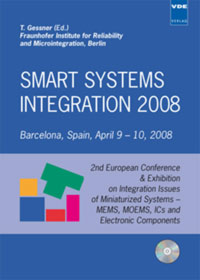Approaches of local stress measurement on microsystem devices
Conference: Smart Systems Integration 2008 - 2nd European Conference & Exhibition on Integration Issues of Miniaturized Systems - MOMS, MOEMS, ICS and Electronic Components
04/09/2008 - 04/10/2008 at Barcelona, Spain
Proceedings: Smart Systems Integration 2008
Pages: 8Language: englishTyp: PDF
Personal VDE Members are entitled to a 10% discount on this title
Authors:
Vogel, Dietmar; Auerswald, Ellen; Gollhardt, Astrid; Michel, Bernd (Fraunhofer IZM, Micro Materials Center, Berlin und Chemnitz, Germany)
Luczak, Falk (Technical University Berlin, Schwerpunkt für Mikroperipherik, Berlin)
Sabate, Neus (Universitat Barcelona, Departament d’Electronica, Spain)
Abstract:
Integration of micro and nano devices causes several new reliability issues to be analyzed and solved. Among them mechanical stresses between and in structural components covering some dimensional magnitudes are one of the concerns. The latter appear as residual stresses resulting from a multitude of different component processing steps manufacturing micro and nano components, as wells as stresses introduced by the nano-to-micro integration, e.g. by the component packaging, or by environmental loads. Unfortunately, stress determination in MEMS/NEMS and their packaging is everything else as a simple task. Finite element simulations should include modeling of complete production steps, having impact on final stress profiles. Realistically, this approach cannot be realized for complex devices. Experimentally, the choice of available stress measurement methods with micro- or even nanoscopic spatial resolution is rather limited. The authors developed a new promising stress measurement technique allowing access to stresses in microscopic and nanoscopic system areas. This method bases on the specific testing feasibilities provided by focused ion beam (FIB) equipment. Ion milling is utilized to release very locally residual stresses on components of interest. Generated this way surface deformations around the milled area are measured by digital image correlation (DIC) algorithms. As a result originally existing residual stresses are computed from measured stress release deformations. The method is being applied to semiconductor structures, MEMS components and packaging materials.


